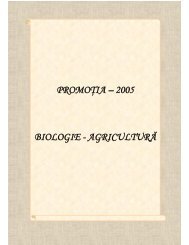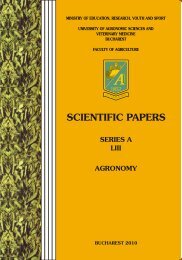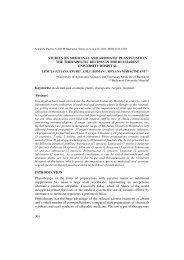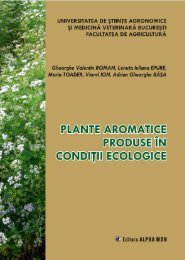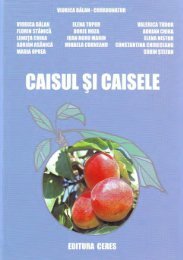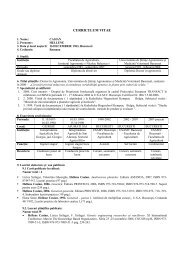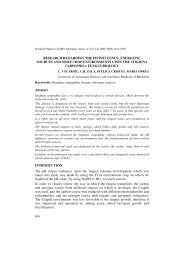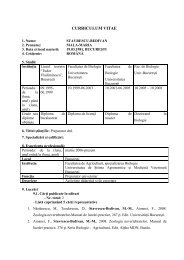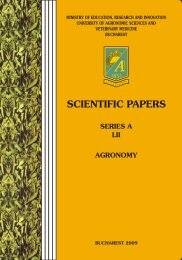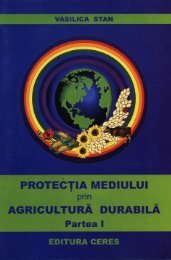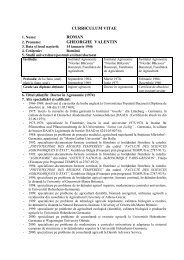WEED CONTROL IN MAIZE CROP BY MECHANICAL AND ...
WEED CONTROL IN MAIZE CROP BY MECHANICAL AND ...
WEED CONTROL IN MAIZE CROP BY MECHANICAL AND ...
You also want an ePaper? Increase the reach of your titles
YUMPU automatically turns print PDFs into web optimized ePapers that Google loves.
Scientific Papers, UASVM Bucharest, Series A, Vol. LIV, 2011, ISSN 1222 - 5339<br />
262<br />
<strong>WEED</strong> <strong>CONTROL</strong> <strong>IN</strong> <strong>MAIZE</strong> <strong>CROP</strong> <strong>BY</strong> <strong>MECHANICAL</strong> <strong>AND</strong><br />
MANUAL MANAGEMENT PRACTICES<br />
A. DAMIAN<br />
Limagrain Romania Company<br />
Keywords: maize, weeds number, mechanical and manual practices, yield quality<br />
Abstract<br />
Mechanical and manual hoeing employed in weed control is an ecological alternative. This<br />
alternative could be easily adopted in an integrated weed management system owing to<br />
regional traditions and success all over the world [13]. We have studied a major crop:<br />
maize, in 11 types: mechanical hoeing, manual hoeing and a combination of both. The<br />
results are shown as weed evolution expressed by the species number, both on the interval<br />
between the rows and the maize rows, at intervals of 20, 40 and 60 days after the<br />
emergence (DAE), i.e. before the two types of works. Weed density in the interval between<br />
rows decreased in time after 20 DAE 40-50, from 40-50 total species 30-40 species, and<br />
dropped below 20 species at 60 DAE. The decrease in weeding level has increased the<br />
average grain yield of better quality. The correlations between different qualitative aspects<br />
of grain yielf (r = 0.704*/protein, r = 0.454/oil, and r = 0.463/ash), recommend the<br />
promotion and implementation of this system of reducing weeding in maize.<br />
<strong>IN</strong>TRODUCTION<br />
As weed-susceptible plant, maize is strongly weeding irrespective of the crop area<br />
[2]. Its relatively wide nutrition area allows invasion by many weed species ever<br />
since the beginning of vegetation [3], resulting from both the sunlight falling<br />
directly on soil and humidity that is usually sufficient for seed emergence. The<br />
germination strength of different weed species is already known [12], as most grow<br />
much faster compared to maize. Weed emergence is slower [7], which leads to the<br />
emergence of a real weed-made green cover.<br />
Mechanical and manual hoeing are applied for weed control worldwide [4, 14], and<br />
in Romania, as their positive effects are very important within a specific cultural<br />
system. There is a question, however, referring to whether such practices can<br />
control a sufficiently large number of weeds [11], so that their competition with<br />
maize (as species number) should not result in obvious/significant loss [5, 6].<br />
Under some cultural conditions [8], weed control by mechanical means has proven<br />
successful, i.e. between 37-95% [4.15], irrespective of works number [5.10].<br />
However, mechanical means is truly effective if applied together with other<br />
collateral factors that contribute effectively to weed control. Agricultural practice<br />
has proven that combining several measures with mechanical hoeing results in
significant changes in weed populations [1]. Moreover, in today's promotion of<br />
integrated weed management, the use of complex weed control in maize, together<br />
with manual and mechanical means, may lead to the maintenance of a weeding<br />
level below the critical damage level.<br />
This paper presents the results obtained from the combination of mechanical and<br />
manual means and in different rates, i.e. the number of works performed to the<br />
maize crop: between 1 and 3, for economic reasons. This type of study might find<br />
an answer to the environmental, and sustainable, requirements regarding weed<br />
control in this valuable crop: maize.<br />
MATERIAL <strong>AND</strong> METHODS<br />
Research was performed at the Caracal Agricultural Research and Development<br />
Station, under the influence of the 2010 climatic conditions, on rich carbonate-type<br />
soil. The LG 33.30 hybrid maize (of the FAO 330 group) was grown under normal<br />
conditions: soil was plowed in autumn, and 2-3 poly-disc works were performed in<br />
spring. Both works specifically decreased weeding [9]. The experiment included 11<br />
variants of 28 m 2 each, in three repetitions (84 m 2 in total). The variants were<br />
placed according to the block method. Mechanical and manual hoeing were made<br />
in a characteristic structure/combination (Table 1).<br />
Table 1<br />
Combination between mechanical and manual hoeing<br />
No. Treatments Mechanical-DAE days Manual-DAE days<br />
var<br />
20 40 60 20 40 60<br />
1. 2 Mec (I,II) Control yes yes<br />
2. 2 man (I,II) yes yes<br />
3. 2 Mec (I,II)+1 man (II) yes yes yes<br />
4. 1 Mec (II)+2 man (I,II) yes yes yes<br />
5. 2 Mec (I,II)+1 man (I) yes yes yes<br />
6. 1 Mec (I)+2 man (I,II) yes yes yes<br />
7. 2 Mec (1,2)+2 man (1,2) yes yes yes yes<br />
8. 2 Mec (I,II)+2 man (I,II) yes yes yes yes<br />
9. 3 Mec +2 man (I,II) yes yes yes yes yes<br />
10. 3 Mec +3 man (1,2,3) yes yes yes yes yes yes<br />
11. 3 Mec + 3 man (I,II,III) yes yes yes yes yes yes<br />
yes – I, II, III = 20, 40, 60 days after emergence, DAE<br />
yes – 1, 2, 3 = 15, 30, 45 days after emergence, DAE<br />
The climatic conditions highlight slightly higher temperatures than the annual<br />
average, while precipitations were higher in the first part of the vegetation period<br />
and under the multi-annual average in the second part (Table 2).<br />
263
Climatic data specific to year 2010<br />
Table 2<br />
Parameters Average, Mar. Apr. May Jun. Jul. Aug. Sep.<br />
total<br />
Temp. T 0 C 2010 6.0 12.3 17.4 21.4 23.6 24.9 18.3<br />
Normal 4.8 11.2 16.6 20.5 22.7 21.9 17.6<br />
Rainfalls, 2010 50.6 64.0 167.4 107.0 6.6 29.4 23.0<br />
mm Normal 34.9 43.6 64.9 67.0 52.9 50.7 39.6<br />
RESULTS <strong>AND</strong> DISCUSSION<br />
Observations performed over several years (in the station), including the research<br />
time length (2010), showed greater, strong maize weeding. The main causes are:<br />
the existence of flower diversity expressed by a large species number, the high<br />
density per unit area, the natural reserve (bankseed) of the cultivated land from<br />
which they emerge every year, and maize as a less competitive crop plant<br />
compared to weeds. The present research clearly shows the possibility to reduce<br />
maize weeding only by employing mechanical hoeing in combination with manual<br />
hoeing.<br />
Weeding evolution during the vegetation period. The weed number measured on<br />
plant interval and row highlighted the actual maize weeding (Figure 1).<br />
Thus, weed number varied significantly, i.e. around 40 species, on the interval<br />
between the lines before the first hoeing (after 20 DAE). Figure 1 shows the<br />
species grouped into four directions: yearly dicotyledons-YD at the base, yearly<br />
monocotyledons-YM and perennial dicotyledons-PD in the middle and perennial<br />
monocotyledons-PM at the top. Representative of these groups were the<br />
problematic weeda: YD: Amaranthus retroflexus, Xanthium italicum, Solanum<br />
nigrum, YM: Setting glauca; PD: Convolvulus arvensis, Cirsium arvense, MP:<br />
Sorghum halepense. The two works showed that before the third stage (60 DAE),<br />
the total number of weed species decreased from 10 to 15. There were structural<br />
changes between weed categories, as a result of hoeing. The weed number (same<br />
types) on rows was relatively constant, i.e. between 15-18 total species. In the<br />
seond stage, apart from mechanical (V1) and mechanical without manual (V3)<br />
hoeing, weeds decreased to approx. 10 species. For the third stage, manual hoeing,<br />
together with the mechanical ones (V5) was not sufficieny to reduce the weed<br />
number. The total weed number decreased under 10 species in the other variants.<br />
The hoeing combination resulted in densities between 3 and 8 species.<br />
264
Total number of<br />
weeds<br />
Weeds number from maize interval, 20<br />
DAR<br />
60<br />
40<br />
20<br />
0<br />
1 2 3 4 5 6 7 8 9 10 11<br />
Variants<br />
Total number of<br />
weeds<br />
Weeds number from maize rows, 20 DAR<br />
20<br />
15<br />
10<br />
5<br />
0<br />
1 2 3 4 5 6 7 8 9 10 11<br />
Variants<br />
Total number of<br />
weeds<br />
Weeds number from maize interval, 40<br />
80<br />
DAR<br />
60<br />
40<br />
20<br />
0<br />
1 2 3 4 5 6 7 8 9 10 11<br />
Variants<br />
Total number of<br />
weeds<br />
Weeds number from maize rows, 40 DAR<br />
40<br />
30<br />
20<br />
10<br />
0<br />
1 2 3 4 5 6 7 8 9 10 11<br />
Variants<br />
Total number of<br />
weeds<br />
Weeds number from maize interval, 60<br />
DAR<br />
100<br />
80<br />
60<br />
40<br />
20<br />
0<br />
1 2 3 4 5 6 7 8 9 10 11<br />
Variants<br />
Total number of<br />
weeds<br />
Weeds number from maize rows, 60 DAR<br />
60<br />
50<br />
40<br />
30<br />
20<br />
10<br />
0<br />
1 2 3 4 5 6 7 8 9 10 11<br />
Variants<br />
Fig. 1. Evolution of weed number (species) and plant on maize interval and<br />
rows in the three vegetation stages<br />
(white-yearly dicotyledons, light grey-yearly monocotyledons, dark greyperennial<br />
dicotyledons, black-perennail monocotyledons)<br />
Correlations between weeding level and maize yield. By mechanical and manual<br />
hoeing, maize benefited from declining weed infestation. The average grain yields<br />
showed significant increases to multiple variants (Table 3).<br />
Thus, if the mechanically-hoed control formed an average of 36.8 q. grains ha -1 , the<br />
variants 3+3 recorded over 80.0 - q. grain ha -1 . Qualitatively, a thousand grain<br />
weight (TGW) recorded a significant growth, and the protein content increased<br />
between 9.2 and 10.2%, oil increased between 3.28 and 4.00%, and ash ranged<br />
between 0.85 and 0.97%.<br />
265
Table 3<br />
Influence of experimental variants on maize grain yield and quality<br />
Nr.<br />
crt.<br />
Variants Yield,<br />
q.ha -1<br />
TGW,<br />
g<br />
Proteins,<br />
%<br />
Oil,<br />
%<br />
Ash,<br />
%<br />
1. 2 Mec (I,II) Control 36.8 275 9.7 3.96 0.87<br />
2. 2 man (I,II) 41.9** 300 9.3 3.28 0.85<br />
3. 2 Mec (I,II)+1 man (II) 46.0*** 282 9.2 3.75 0.79<br />
4. 1 Mec (II)+2 man (I,II) 51.6*** 294* 9.6 3.84 0.88<br />
5. 2 Mec (I,II)+1 man (I) 57.2*** 308** 10.0 3.74 0.93<br />
6. 1 Mec (I)+2 man (I,II) 61.8*** 303** 9.8 3.37 0.94<br />
7. 2 Mec (1,2)+2 man (1,2) 74.9*** 312*** 10.1 3.88 0.89<br />
8. 2 Mec (I,II)+2 man (I,II) 77.8*** 315*** 9.6 4.00 0.87<br />
9. 3 Mec +2 man (I,II) 79.0*** 315*** 9.8 3.91 0.84<br />
10. 3 Mec +3 man (1,2,3) 84.3*** 323*** 10.1 3.91 0.91<br />
11. 3 Mec + 3 man (I,II,III) 88.2*** 323*** 10.2 3.94 0.97<br />
DL 5 % =<br />
DL 1 % =<br />
DL 0.1 % =<br />
3.44<br />
4.68<br />
6.34<br />
16.6<br />
22.7<br />
30.7<br />
0.73<br />
1.04<br />
1.50<br />
0.534<br />
0.760<br />
1.100<br />
0.357<br />
0.508<br />
0.735<br />
Maize grain quality. There was a strong correlation between the weed number and<br />
the grain yield (I = 0.822), which proves the need to reduce the weed number by<br />
applying these methods (Figure 2).<br />
Grain yields, t/ha<br />
Yhe maize grain formation by weeds total number<br />
10<br />
8<br />
6<br />
4<br />
2<br />
0<br />
y = 18,852x -0,3389<br />
I = 0,822<br />
0 20 40 60 80 100<br />
Weeds total number<br />
Proteins, %<br />
10,4<br />
10,2<br />
10<br />
9,8<br />
9,6<br />
9,4<br />
9,2<br />
9<br />
T he protein contents from maize grains<br />
y = 0,1275x + 8,9521<br />
r = 0,704*<br />
0 2 4 6 8 10<br />
Grain yields, t/ha<br />
Oil, %<br />
5<br />
4<br />
3<br />
2<br />
1<br />
T he oil content from maize grains<br />
y = 0,0604x + 3,3957<br />
r = 0,454<br />
0<br />
0 2 4 6 8 10<br />
Grain yields, t/ha<br />
1,2<br />
1<br />
0,8<br />
0,6<br />
0,4<br />
0,2<br />
0<br />
T ha ash content from maize grains<br />
y = 0,013x + 0,8026<br />
r = 0,463<br />
0 2 4 6 8 10<br />
Maize grain yields, t/ha<br />
Fig. 2. Corelations between maize yield under weeding and grain qualitative<br />
indices<br />
Ash content, %<br />
266
Protein content recorded a favourable increase: r = 0.704 *, with a growth rate of<br />
0.1275% per grain tonne. Oil content increased slightly: r = 0.454, at a rate of<br />
0.06% per tonne, and ash recorded a good evolution: r = 0.463, at a rate of 0.013%<br />
per tonne grain.<br />
CONCLUSIONS<br />
1. The initially high total number of weed: 40 per interval, 17 per row,<br />
demonstrates the need to reduce weed infestation. One method is mechanical<br />
and manual hoieng performed together, not separately. After 60 DAE, 20<br />
species were found on the interval and 3-7 species per row.<br />
2. In the Caracal area, the problematic weeds were: Amaranthus retroflexus,<br />
Xanthium italicum, Solanum nigrum-YD, Convolvulus arvensis, Cirsium<br />
arvense-DP, Sorghum halepense-PD and Setaria glauca-MP.<br />
3. Yield grain increased significantly from 36.8 in the control to 88.2 q.ha -1 in<br />
V 11 – 3 mec + 3 man. (I,II,III). Maize grains have recorded better quality:<br />
TGW increased by 48 g, protein by 1%, oil by 0.72%, and ash by 0.18%.<br />
4. The correlations between different grain measurements showed that yield<br />
formation depends on weed infestation, expressed as species number, as<br />
follows: r=0.704*, oil content r=0.454, and ash r=0.463, in grains.<br />
REFERENCES<br />
1. Albrecht H., 1995. Changes in the arable weed flora of Germany during the last five<br />
decades. 9 th EWRS Symposium (pp. 41- 48).<br />
2. Berca M., A. Ciorlaus, 1994. Buruienile-un flagel indubitabil al agriculturii.<br />
Simpozionul 9 SRSCB (Societatea Romana pentru Studiul si Combaterea<br />
Buruienilor), Constanta (pp. 11-15).<br />
3. Courtney A.D., 1996. Teoria si practica folosirii pragurilor de imburuienare.<br />
Simpozionul 10 SRSCB, Sinaia (pp. 265- 273).<br />
4. Derksen D.A., G.P. Laford, A.G. Thomas, H.A. Loeppky, C.J. Swanton, 1993.<br />
Impact of agronomic practices on weed communities: tillage systems. Weed<br />
Science, vol. 41 (pp. 409- 417).<br />
5. Froud-Williams R.J., 1995. Integrated weed management: the challenge for weed<br />
science into the 21 st century. 9 th EWRS Symposium (pp. 491- 498).<br />
6. Gus P., P.M. Sebok, 1995. The impact of cultivation technologies on weed<br />
infestation and crop yield. 9 th EWRS Symposium (pp. 605- 609).<br />
7. Hall, M.R., C.J. Swanton, G.W. Anderson, 1992. The critical period of weed control<br />
in grain corn (Zea mays), Weed Science, vol. 40 (pp. 441- 447).<br />
8. Ionescu N., A. Perianu, A. Popescu, N. Sarpe, C. Roibu, 1996. Weed control in corn<br />
and soybean crops by mechanical and manual practices. Proceedings of 10 th<br />
267
268<br />
Colloque International sur la Biologie des Mauvaises Herbes, Dijon, France (pp.<br />
359- 365).<br />
9. Lazauskas P., 1995. Strategy of non chemical weed control. 9 th EWRS Symposium<br />
(pp. 571- 576).<br />
10. Rasmussen J., 1992. Testing harrows for mechanical control of annual weeds in<br />
agricultural crops. Weed Research, vol. 32 (pp. 267- 274).<br />
11. Richards M.C., 1989. Crop competitiveness as an aid to weed control. Brighton<br />
Conference- Weeds (pp. 573- 578).<br />
12. Sagar G.R., 1968. Weed biology-a future. Netherlands Journal of Agricultural<br />
Science, vol. 16 (pp. 155- 164).<br />
13. Swanton C.J., S.F. Weise, 1991. Integrated weed management: The rationale and<br />
approach. Weed Technology, vol. 5 (pp. 657- 663).<br />
14. Townson J.K., A.R. Jutsun, K.A. Powell, 1995. Impact of technology on weed<br />
control. 9 th EWRS Symposium (pp. 11- 20).<br />
15. Van Der Wiede R., A. Krikke, F. Wijnands, 1995. Technical and economic<br />
feasibility of mechanical weed control in arable farming in the Netherlands. 9 th<br />
EWRS Symposium (pp. 483- 490).



